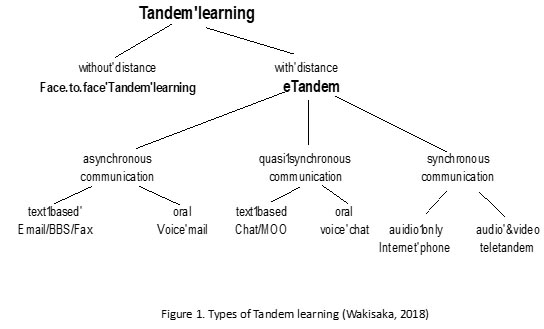1. Definition
Brammerts (2001/2005) defined tandem learning like this. “When learning a language in tandem, two people with different mother tongues work together in order to learn from each other.” There are two important principles in tandem learning, “reciprocity” and “learner autonomy”. Reciprocity is a relationship in which two partners help each other in order to progress in his/her learning ability and skill, and to accomplish an individual goal. Learner autonomy is the ability to take control of one’s own learning. Each of the tandem partners decides what he/she wants to learn, how and when, and what kind of help he/she would like from his/her partner.
2. Advantage of Tandem learning
According to previous research, tandem learning is effective in:
◆Improving second language proficiency(Kotter, 2002;Lewis, 2003)
◆Fostering learner autonomy(Little, 2003;Sasaki & Takeuchi, 2011)
◆Raising intercultural awareness and developing intercultural competence(Dodd, 2001;Stickler & Lewis, 2003;Woodin, 2001; 2003)
◆Increasing and maintaining language learning motivation(Appel & Gilabert, 2002;Bower, 2007;Tian & Wang, 2010;Ushioda, 2000;Wakisaka, 2013)
◆Forming a sense of friendships(Aoki, Wakisaka & Ou, 2013;Hiranaka, Tei & Ra, 2011)
◆Developing confidence in speaking a target language(Meguro, 2007;Stewart & Aoki, 2013;Wakisaka, 2012), and
◆Stimulating motivation to study abroad(Okochi, 2011).
3. History
Now I would like to introduce the historical development of tandem learning. It is impossible to pinpoint when and where the learning format of a pair of people learning from each other actually started. It is because tandem learning was originally a “widespread practice rather than a method based on theory.” (O’Rourke, 2007, p. 43). Therefore, it has been refined as practiced and has taken its current form of being practiced based on the two principles, reciprocity and learner autonomy. However, we can identify when the term “tandem” started to be used. It is said that this learning format was first called “tandem” in Germany and France in the late 1960s. After World War II, the Franco-German Youth Office (Deutsche-Französische Jurgend Werk: DFJW) was established so that two neighbors, Germany and France, would not start the war again. There, they started “tandem learning” where German youth and French youth exchanged each other’s languages. After that, tandem learning was adopted for foreign workers in the early 1970s and for language schools in the late 1970s. In the mid-1980s, tandem learning was adopted in university helped by increasing mobility of students among institutions of higher education due to the intensifying movement toward European integration. When Germany was reunified in 1989 due to the political change of Eastern Europe, “International Tandem Day (Internationalen Tandem-Tagen)” was implemented in Switzerland for the first time. Thus, the place to practice tandem learning at institutions of higher education has been further developed. Together with such widespread practice, knowledge of tandem learning has accumulated, and its practical aspect was refined. The two principles, “reciprocity” and “learner autonomy” were established during practice. Furthermore, “eTandem,” where partners communicate via the Internet, was implemented due to the rapid development and spread of information technology since the 1990s. In particular, the International Email Tandem Network, which is the largest tandem learning network in Europe, was founded by Helmut Brammerts and others of the Ruhr University Bochum in 1994 (Brammerts, 2001/2005). This network using the Internet has spawned bilingual subnets of 20 different languages including Japanese and Korean by 1996 (Tandem-Server Bochum Homepage). eTandem using free instant messengers, MOO , and Internet phone services has been conducted since the 2000s because CMC (Computer-mediated communication) became part of everyday communication. Especially, tandem learning, where learners see each other in real time using webcams via the Internet, has been conducted on a large scale, led by the Universidade Estadual Paulista in Brazil since around 2006. This is called “Teletandem”. In recent years, the practice of Teletandem has attracted much attention of those who are involved in language education due to the remarkable advancement of information technology and the expansion of Internet use. It seems that it will keep growing in the future.
4. Different Types of Tandem Learning
This figure1. shows different types of Tandem learning.

eTandem includes asynchronous communication, Quasi-synchronous and synchronous communication. Synchronous communication via video conferencing offers advantages similar to those of face-to-face tandem. Since 2006, Internet telephone with webcam has been called “Teletandem”. However, different researchers use other terms, such as video conferencing and telecollaboration.
